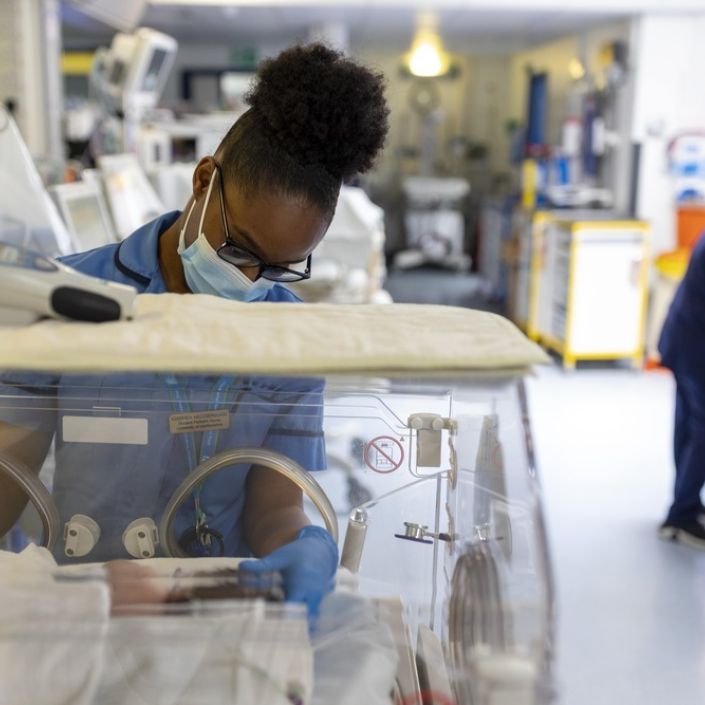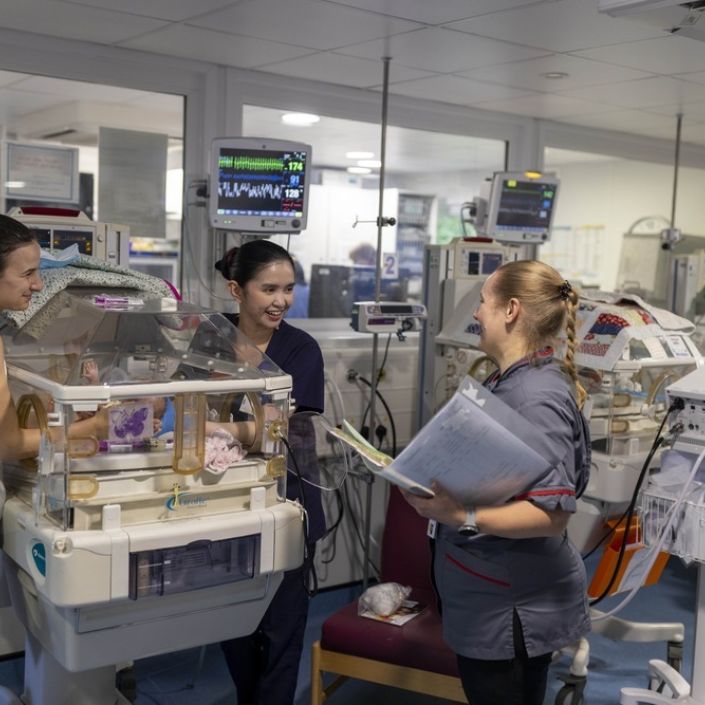You might not have had any time with your baby after they were born and before they went to the unit.
Many parents tell us that seeing their baby in the incubator and attached to wires makes them feel distanced from them. There can also be sounds from equipment which can seem alarming at first. This can feel very upsetting.
Some parents find it helpful to know what the equipment does and how it helps to monitor and provide support for their baby. If you are ever unsure about the equipment used for your baby, ask the neonatal team – they will be happy to explain.
Incubator
Incubators are clear boxes which help keep your baby warm. Premature or sick babies can struggle to stay warm on their own.
Some incubators are closed boxes with hand holes on the side. This helps keep the heat and humidity in the incubator, stopping too much moisture evaporating from your baby’s fine skin.
Other incubators have open tops and an overhead heater or heated mattresses.
The temperature is controlled in two ways – either with controls or using an automatic sensor on your baby's skin. If the sensor falls off or is not working properly, an alarm sounds, and a nurse will check the temperature of the incubator.
Ventilators and breathing machines
Before your baby was born, they received all the oxygen they needed from their birth parent. The oxygen in the birth parent's blood passes across the placenta and into the umbilical cord (the cord that connects the baby to the placenta and which is cut at birth).
Once they are born, babies get their oxygen by breathing. If a baby is born prematurely or with a medical condition, they may struggle to breathe by themselves. Premature babies' lungs in particular might not be developed enough to manage breathing by themselves yet.
Depending on what your baby needs, they might be put on a machine called a ventilator – this helps your baby to breathe.
There are two types of basic ventilator:
Ventilators: These blow air with or without added oxygen (depending on what your baby needs) gently into your baby’s lungs through a tube which is passed through their nose or mouth. This inflates your baby’s lungs and is adjusted depending on what your baby needs.
High frequency oscillating ventilators: These blow small amounts of air, with or without added oxygen, (depending on what your baby needs) into the lungs very quickly, hundreds of times a minute. Your baby’s chest will look like it is vibrating. This might look worrying, but it can work very well for some kinds of lung conditions.
Other breathing machines can include:
Continuous positive airway pressure (often shortened to 'CPAP')
These blow air, with or without oxygen, (depending on what your baby needs) through two thin tubes in your baby’s nose, or through a small mask over their nose. CPAP slightly raises the pressure of the air, which helps keep your baby’s lungs inflated.
Non-invasic positive pressure ventilations (also called BiPap)
This is given through a mask or a small tube in your baby's nose and helps to regulate their breathing.
Heated, humidified high-flow nasal cannula (also called 'high-flow' or 'optiflow')
Some babies need help with their breathing but do not need something as strong as a ventilator. High-flow is where warm, moist air with or without oxygen (depending on what your baby needs) flows into your baby’s lungs through small tubes in their nose.
Endotracheal (pronounced en-doe-track-eel) tube
This is put down your baby's windpipe (called a trachea by health professionals) if they are on a ventilator. It is either put in through your baby's nose or mouth. It is the tube which passes the air into your baby's lungs from the ventilator.
Vital signs monitor
These machines pick up electrical signals given out from your baby’s heart, and always check that it is beating properly. They can also pick up changes in your baby's breathing. These monitors pick up these signals through small pads put on your baby’s chest. Wires run from the pads to the monitoring machine.
Oxygen saturation monitor
These monitors check the amount of oxygen in your baby's blood, by shining a light through their skin. The sensors are strapped gently to your baby’s foot or hand.
Intravenous (pronounced in-tra-vee-nus, and sometimes shortened to IV) drip
Your baby might have thin tubes (sometimes called IVs, drips or cannulae) put into a tiny blood vessel. The IV is usually put in a hand, foot, arm or leg. Sometimes the staff might have to use one of the tiny veins on the surface of your baby’s head. These tubes are there to give fluids or medication, like antibiotics.
Feeding tube
If your baby can't feed by themselves yet, they might be able to have breast milk or formula through a tube that goes down their mouth or nose and into their stomach. Doctors might use a nasogastric (pronounced nase-oh-gas-trick) or orogastric (pronounced or-oh-gas-trick) tube.
For more information about feeding, visit our page about being a parent on the neonatal unit.



